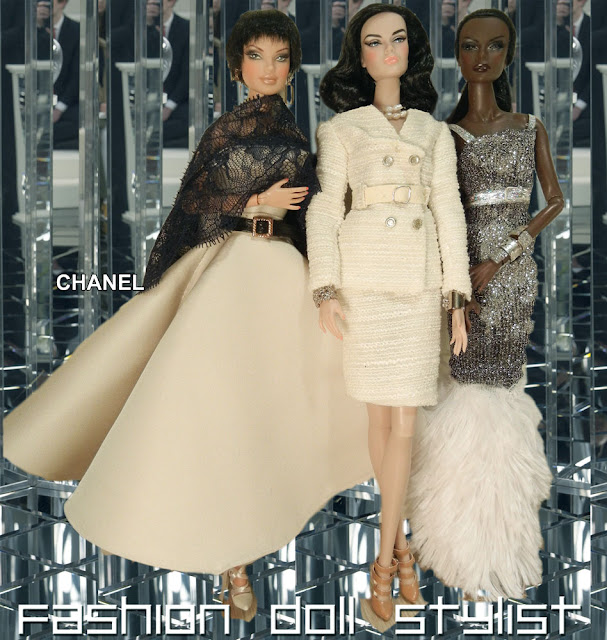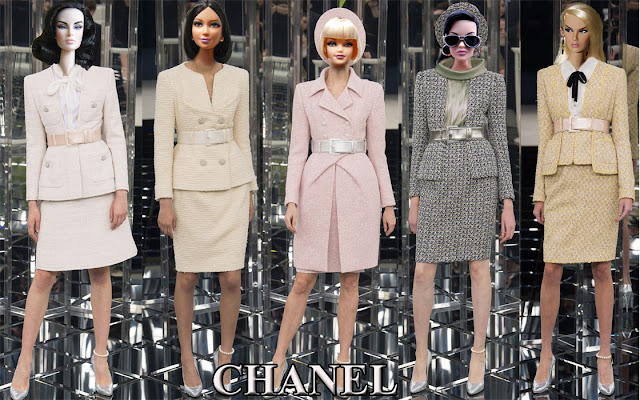The idea for this post came out of a suggestion of reader, Karen who admired a stunning black gown by Stephane Rollin in my last post on Paris Couture. Not only was it a great idea, but it is one that we will be seeing lots of at the Academy Awards' red carpet just a few days away.
The train dates back to the Middle Ages when the aristocracy used this trail of fabric to express their social status. The longer the train, the more important the bride's place was in society. It was eventually adapted into the dress of Europe's high court for other types of affairs. Today, other than wedding dresses, trains are seen on gown worn to black tie events like opera premiers or prestigious red carpet spectacles like the Oscars.
 |
| (From upper left to right): Sheer polyester, sheer silk georgette, 2-way rayon jersey, pink silk satin (Lower left to right): medium weight polyester satin, light weight silk satin, sheer cotton muslin, silk chiffon. |
Before we get started, you have some design decisions to make. Does your doll want a big, cotillion gown with lots of fullness all around? Or does she want something slinky with a dress that drips off her vinyl hips into a pool of jersey? Perhaps all you want is trail of chiffon cascading from her delicate shoulders. How long and how wide do you want dolly's train and what shape does it take at the end: round, oval or in a point? Your choice of fabric will also impact the look of your gown. Depending on the weight and sometimes the fiber content, the dress will either be light and "fluffy" or statuesque with folds falling like Grecian columns. If possible, take the doll with you to the fabric store and hold a corner of the fabric to the waist of the doll to get an idea as to what you can expect.
Circle of Life
I begin with a circle skirt with an 8 inch (20cm) train. (You can add a
corset or some other top of your choice for an endless combination of looks.) A circle skirt with an 8 inch train is a big pattern, so for this project, I am using tissue paper (recycled from the packaging of many things I buy on eBay). This will also help me to visualize the skirt before I start with fabric!
1. I begin with the draft of the circle skirt. It is a full skirt with a single seam, planned for the left side of the doll. (For this skirt, I didn't want a seam down the middle of the train.) You should also draw a line indicating the center front and the center back of the skirt.
2. Fold the skirt in half and hold next to the back waist of the doll.
3. Here is where you should decide on the length of the train. Tape another sheet of paper under the skirt.
4. Trace the curve of the circle onto another sheet of paper.
5. Place that curve where you feel the train should end. You can decide to make it longer or shorter at this point.
6. Once you decide on the length, measure from the end of the skirt to the end of your planned train. Tape down. Extend the center line of the skirt to the end of where you want the train to end.
7. From the circle to the end of where you want the train, draw a new curve. You only need to do half.
8. When you are happy with the shape of the train, you will eventually trace this half onto the other side.
9. Cut the pattern out. Be sure to cut along the side seam.
10. Put the tissue paper pattern back on the doll. (Tape to her.) Then decide if you are happy with the distribution of fullness and shape of the skirt. Here, I decided I wanted the skirt to hang lower in the front and further out at the sides.
11 Tape on more paper to one side only. Mark a new hem.
12. Try it back on the doll. Make adjustments if necessary. In my case, I was happy with the skirt.
13. When you are happy with the look, remove the pattern from the doll. Trace the adjustments you made on the one side to the other. It's time to cut out the fabric.
14. To line or not to line. Linings add bulk and result in fewer folds in the garment. If big and fluffy is what you want, there's no problem. But if you want something slinky or sheer (lace, for example), it's better to forget the lining and hand roll the edges and hemline. You also have the option of putting in free hanging lining (joined together only by the waist and side seam) and hem each layer. OR....hem the top layer and add ruffled lace to the underskirt. One more point---even though the gown is big, the lining can take the form of a smaller sheath dress underneath which allows the outside to fall as it may without the bulk.
13. In any case, I've suspended this skirt from a small waistband, closed by a small hook & eye. Again, beware of adding bulk. I use ribbon and sometimes the selvage edge from the fabric which I stitch on top of the skirt.
 |
| Seamless train |
Train Station

With this project, I want to show you how to create a train for an existing pattern. For best results choose one that has some flare at the sides. I had a pattern (strapless, flared sheath with a dart at the bust) for a red carpet dress I made awhile back. For this project I modified it to create the Stephane Rollin Haute Couture dress.
Note: I'll show how I arrived at my pattern at the very end. But for the moment I want you to understand how to create a train for any style of dress.
1. Begin by lining up the front and back pattern pieces together along the side seams from the waist down. Place them over another piece of paper so we can create a new pattern.
2. On the center back line, draw a line from the hem to the length of the train you want. Trace the existing hemline onto the tissue paper. Sketch in the shape of the train from the narrow point at the side to the very end of the train.
3. Cut the extension you've just created and tape onto the hem of your pattern.
Again, try this tissue paper pattern on the doll and make any adjustments you feel necessary. Here, I was pretty happy with the look of this dress.
For this dress, I selected a 2-way stretch rayon jersey. It is lightweight but hangs extremely well, falling into sculptural folds from the doll's hips. For that reason I didn't want to fully line this dress. So I decided to do a waist-length foundation which would add structure at the top but allow the dress to hang free. I chose a lightweight cotton interfacing. I traced the dress pattern to just below the waist. This "foundation" is attached to the dress along the top edge of the dress. A hook and eye is used to close the dress at the back. The "lily" was cut from a small bit of sheer cotton with a few tucks.
What happens if you want to use a dress with princess line construction?
1. Here is a classic princess line dress.
2. Put the front aside and line up the other pieces along the side seam lines. So, back to side back, side back to front back.
3. Place on another piece of paper. Extend the lines where the patterns touch. Trace off the hemline. Extend the center back line to the length of your train.
4. Again, starting from point zero on the side front to the very end of the train at the center back hem, sketch out the shape.
5. Cut out those additions and tape to the original pattern.
6. Here is what my princess line pattern with a train resembles.
A few simple ideas...
If you feel this is completely over your head, there are a few simpler ideas at hand.
This is a simple empire waist dress that I've simply added a small length of chiffon to the bustline. It is stitched over the bodice and allowed to trail down the back.
In this instance, I took an existing dress and added a train. This is simply a rectangle that I have hemmed and gathered on one end. I stitched it to one side of the dress but left it free on the opposite side.
It is held in place with a hook and eye.
FYI...
For those of you curious about the pattern I used for the Stephane Rollin gown. I'll do this quickly (since this post is already very long and this duplicates information already on the blog). I'm using a short version of the dress which I then modify over the bust line. If you decide to do this dress, don't forget to lengthen it to floor length and don't forget to add seam allowance.
1) This dress began using basic slopers. I moved the waistline dart of the
bodice sloper to the side. I mark the point where the new dart will be and cut along this horizontal line to the apex of the dart. 2) Fold the waist dart and the new side dart appears. 3)The new pattern. 4) On the front
skirt sloper, draw a vertical line straight down to the hem and cut. 5) Close the dart and the hem widens. 6) The new flared skirt pattern.
1) Along the center front, line up the bodice and the skirt pattern at the front waistline point on the CF. 2) Make a curve where the side of the top meets the skirt. 3) Redraw the front pattern. Trace to the other side to make a full front pattern. Draw the new neckline. In this case, it's asymmetrical. 4) Cut away to create the new pattern. Here, I've put a dotted line to indicate the cutting line for my foundation garment.
The back is composed in the same manner as the front. For the backbodice, I've moved the dart to the armhole (basically to move it out of the way). And for the skirt, closing the dart, shifts volume to the hem.
Again, back bodice and back skirt are lined up at the CF waist point. A new pattern is created after a drawing a curve where the top and bottom meet.
1)We need to redraw the neckline. But to do this, we need to line up the front to the back. Make sure that the sides line up (making any adjustment as needed). 2)Mark where the top of the front meets the back. Draw the new neckline on the dress back. 3) Make the new pattern. 4)Using the techniques described earlier, complete the pattern for the gown as well as for the foundation garment.
We have a lot of exciting things on the horizon. Fashion week is in full force. Next weekend, Hollywood is the focus when the Academy Awards will take place. Oh....and did someone say...CARNIVAL!!!???
All images and text property of FashionDollStylist 2017. Please do not reproduce without permission. Thank you.
Like us on Facebook: facebook.com/FashDollStylist
We're also on Pinterest: pinterest.com/FashDollStylist
Come join us on Instragram and show off your stuff: instagram.com/fashiondollstylist

























































